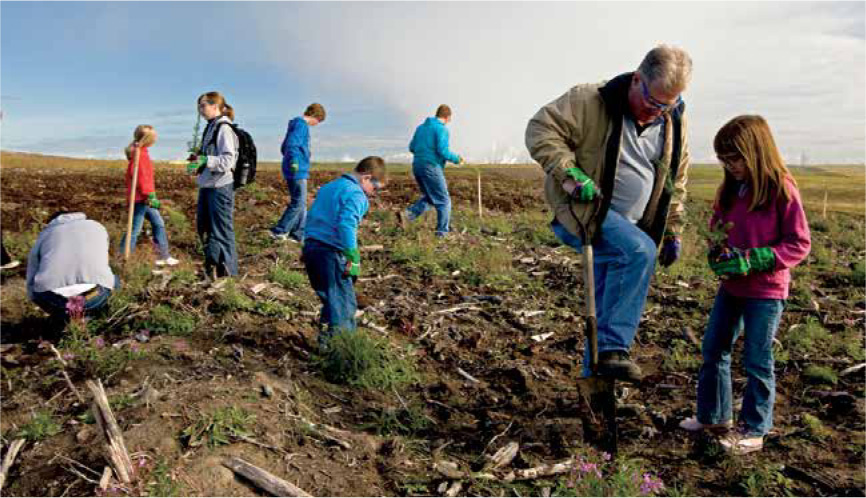6.5 Ecosystems are complicated, but learning how they function will help us restore degraded ones.
Biosphere 2 taught scientists that Earth is far too complex, that ecosystem components intertwine in far too many complicated ways, for humans to recreate. Each is governed by a countless array of interacting factors and a change in one can set off a whole chain of events that degrade the system’s capacity to sustain life.
109
Three years after the first mission was completed, the editors of the respected journal Science deemed the entire project a failure.
From a scientific point of view, the fact that Biosphere 2 was not able to sustain life as hoped does not mean the project was of no value. Negative results can be just as informative as positive ones—in some cases even more so because they uncover gaps in our knowledge and help us decide how to move forward. In fact, Biosphere 2’s greatest liability—its skyrocketing CO2 levels—proved to be its most valuable asset. “Now it’s like a time machine,” says Griffin who points out that it is allowing us a look at the consequences of elevated atmospheric CO2 levels, the main contributor to climate change today. Recent research by Griffin has uncovered some of the complexities of carbon cycling. His group saw unexpected fluctuations in carbon release at various levels in the tree canopy, telling him there is much we still don’t know about how carbon cycles—data that could only be gathered in an enclosed forest such as that found in Biosphere 2. Today, scientists from all over the world still use the facility to study the effects of an atmosphere loaded with carbon dioxide. Ultimately, though, the most valuable lesson Biosphere 2 has provided is how irreplaceable Biosphere 1 is. 
Select references in this chapter:
Cohen, J.E., and Tilman, D. 1996. Science, 274: 1150–1151.
Griffin, K.L., et al. 2002. New Phytologist, 154: 609–619.
BRING IT HOME: PERSONAL CHOICES THAT HELP
Nutrient cycling is critical for maintaining Earth’s ecosystems, but we interfere with nutrient cycles through our daily activities. Driving a car interferes with the carbon cycle by releasing carbon from fossil fuel reservoirs. Applying synthetic chemical fertilizers to food crops interferes with the nitrogen cycle by adding soluble nitrogen compounds to aquatic ecosystems through runoff. The challenge is to figure out ways to work with nutrient cycles rather than against them—in other words, to return nutrients to the reservoirs from which they come. How might this be done in our daily lives and in our own communities?
Individual Steps
 Reduce your fossil fuel use to curtail carbon, nitrogen, and sulphur emissions. Take public transportation, walk, ride a bike, and drive a fuel-efficient vehicle.
Reduce your fossil fuel use to curtail carbon, nitrogen, and sulphur emissions. Take public transportation, walk, ride a bike, and drive a fuel-efficient vehicle.
 Compost food and yard waste. Then use this material to fertilize flowerbeds, trees, and garden plots. Composting will reduce or eliminate the need for inorganic fertilizers in your yard.
Compost food and yard waste. Then use this material to fertilize flowerbeds, trees, and garden plots. Composting will reduce or eliminate the need for inorganic fertilizers in your yard.
 If you cannot compost your organic waste at home, participate in your municipal organic waste program, often called a "green bin" program. Over 65% of organic waste composted at waste management facilities in Canada comes from households.
If you cannot compost your organic waste at home, participate in your municipal organic waste program, often called a "green bin" program. Over 65% of organic waste composted at waste management facilities in Canada comes from households.
Group Action
 Participate in or organize an event to plant trees or native grasses. By doing so, you can help recapture the carbon put into the atmosphere by driving a car.
Participate in or organize an event to plant trees or native grasses. By doing so, you can help recapture the carbon put into the atmosphere by driving a car.
 Many urban areas welcome individuals who are willing to plant native trees, shrubs, and wildflowers in school grounds, parks, and other public spaces.
Many urban areas welcome individuals who are willing to plant native trees, shrubs, and wildflowers in school grounds, parks, and other public spaces.
Policy Change
 Support legislation to increase fuel efficiency of vehicles and subsidies for clean, renewable energy. More fuel-efficient cars and cleaner energy sources will reduce our carbon outputs from fossil fuel use.
Support legislation to increase fuel efficiency of vehicles and subsidies for clean, renewable energy. More fuel-efficient cars and cleaner energy sources will reduce our carbon outputs from fossil fuel use.

110